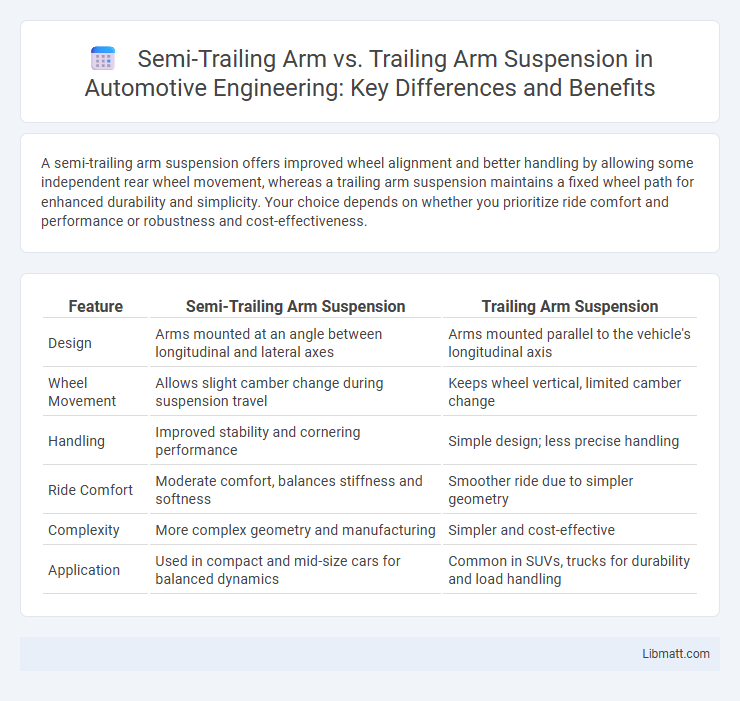A semi-trailing arm suspension offers improved wheel alignment and better handling by allowing some independent rear wheel movement, whereas a trailing arm suspension maintains a fixed wheel path for enhanced durability and simplicity. Your choice depends on whether you prioritize ride comfort and performance or robustness and cost-effectiveness.
Table of Comparison
| Feature | Semi-Trailing Arm Suspension | Trailing Arm Suspension |
|---|---|---|
| Design | Arms mounted at an angle between longitudinal and lateral axes | Arms mounted parallel to the vehicle's longitudinal axis |
| Wheel Movement | Allows slight camber change during suspension travel | Keeps wheel vertical, limited camber change |
| Handling | Improved stability and cornering performance | Simple design; less precise handling |
| Ride Comfort | Moderate comfort, balances stiffness and softness | Smoother ride due to simpler geometry |
| Complexity | More complex geometry and manufacturing | Simpler and cost-effective |
| Application | Used in compact and mid-size cars for balanced dynamics | Common in SUVs, trucks for durability and load handling |
Introduction to Suspension Systems
Semi-trailing arm suspension offers a compromise between performance and comfort by allowing controlled wheel movement and better handling compared to traditional trailing arm setups. Trailing arm suspension typically features arms that extend directly backward from the chassis, providing a simpler design often found in older or budget vehicles, but with less lateral stability. Modern vehicles favor semi-trailing arm systems due to their ability to improve ride quality, reduce unsprung weight, and enhance traction during cornering.
What is a Trailing Arm Suspension?
A trailing arm suspension is a type of rear axle setup where the suspension arms are mounted forward of the axle, allowing the wheels to move in an arc during suspension travel. This design provides better ride comfort and improved handling on rough roads by controlling wheel movement relative to the chassis. Understanding the differences between semi-trailing arm and trailing arm suspensions can help you choose the right setup for enhanced vehicle stability and performance.
What is a Semi-Trailing Arm Suspension?
A semi-trailing arm suspension is a type of independent rear suspension commonly found in compact and mid-sized vehicles, where each wheel is mounted on an arm that pivots near the vehicle's centerline but angles backward. This design allows a balance between ride comfort and handling performance by permitting both vertical wheel movement and camber change during suspension travel. Compared to a trailing arm suspension, which has arms mounted parallel to the vehicle's longitudinal axis, the semi-trailing arm offers improved stability and cornering capabilities due to its geometry and kinematic characteristics.
Key Structural Differences
Semi-trailing arm suspensions feature control arms angled between longitudinal and lateral axes, enabling improved wheel alignment and camber control during suspension travel. Trailing arm suspensions use arms mounted parallel to the vehicle's longitudinal axis, primarily controlling wheel movement along the fore-aft direction with less impact on camber changes. The semi-trailing arm design enhances handling and ride comfort by allowing more complex wheel geometry adjustments compared to the simpler, more rigid trailing arm configuration.
Advantages of Trailing Arm Suspension
Trailing arm suspension offers superior durability and load-bearing capacity, making it ideal for heavy-duty and off-road vehicles. Its simple design enhances ride comfort by isolating road shocks more effectively, leading to improved stability on rough terrains. You benefit from easier maintenance due to fewer moving parts compared to semi-trailing arm setups.
Advantages of Semi-Trailing Arm Suspension
Semi-trailing arm suspension offers improved handling and ride comfort by allowing better wheel alignment during cornering, resulting in enhanced tire contact with the road. This design reduces unsprung weight compared to traditional trailing arm setups, contributing to a smoother and more responsive driving experience. Your vehicle benefits from increased stability and precise control, especially on uneven surfaces.
Performance and Handling Comparison
Semi-trailing arm suspension offers improved handling and better camber control during cornering, resulting in enhanced vehicle stability and responsiveness compared to the traditional trailing arm setup. Trailing arm suspensions generally provide a smoother ride on straight roads and are simpler in design but often compromise handling precision and tire contact during aggressive maneuvers. Vehicles equipped with semi-trailing arms benefit from a balanced blend of comfort and dynamic performance, making them preferable for sporty driving conditions.
Typical Applications in Modern Vehicles
Semi-trailing arm suspensions are commonly used in compact and mid-size cars for their balance between ride comfort and handling performance. Trailing arm suspensions are typically found in larger vehicles like trucks and SUVs, providing durability and better load-carrying capacity. Your choice depends on the vehicle's purpose: semi-trailing arms enhance agility in passenger cars, while trailing arms deliver robustness for heavy-duty applications.
Maintenance and Durability Considerations
Semi-trailing arm suspensions require more frequent maintenance due to their complex geometry and additional pivot points, which can lead to accelerated wear on bushings and joints. Trailing arm suspensions offer greater durability with simpler design and fewer moving parts, resulting in lower maintenance costs over time. For your vehicle, choosing a trailing arm setup may provide enhanced reliability and reduced service intervals, especially in rugged driving conditions.
Choosing Between Semi-Trailing and Trailing Arm Systems
Choosing between semi-trailing arm and trailing arm suspension systems depends on desired vehicle dynamics and packaging constraints. Semi-trailing arm designs offer improved wheel camber control and better handling on uneven roads, making them suitable for sporty or performance-oriented vehicles. In contrast, trailing arm systems provide superior ride comfort and durability, often preferred for trucks and off-road applications requiring robust load-bearing capabilities.
Semi-trailing arm vs Trailing arm Infographic

 libmatt.com
libmatt.com